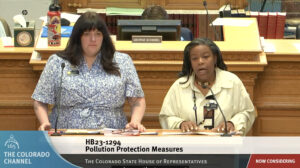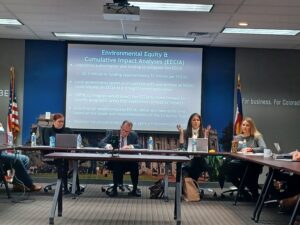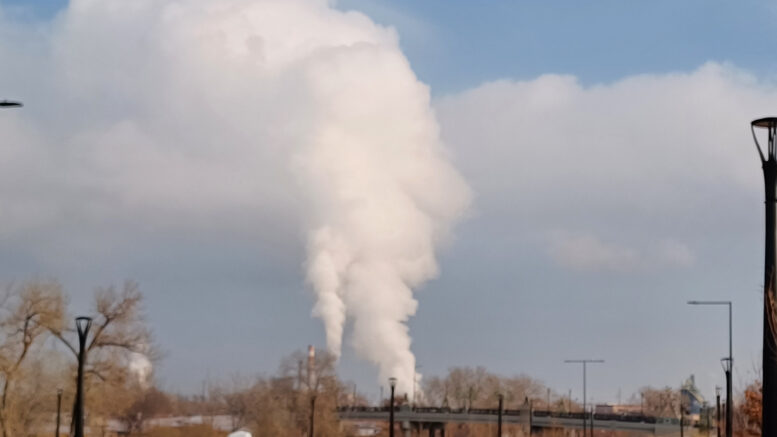Colorado energy producers are awaiting what they expect will be multiple new regulatory proposals in the 2024 legislative session. An unknown number could be coming from an interim committee that recently wrapped up its work, and a recently revealed plan from the state could give local governments more power to block new emissions-generating facilities.
The efforts come even after the Colorado Air Quality Control Commission just finished one of its most active years ever, approving new regulations on commercial buildings, large manufacturing plants, oil-and-gas drilling operations and emitters in disproportionately impacted communities. Oil-and-gas industry executives are becoming concerned that state legislators are looking at their sector alone to solve the state’s greenhouse-gas-emissions issues, despite repeated statements from state officials that cuts in areas from transportation to utilities are needed.
Those concerns grew following the final meeting of the Legislative Interim Committee on Ozone Quality, which took place on Dec. 8. The committee met for four months to hear from state agencies, environmental groups and some industry leaders on the causes of ground-level ozone, and much of its discussion focused on boosting modeling and measurement requirements in air-quality permitting.
Legislators who created the committee in House Bill 23-1294 took the unusual step of denying it the ability to introduce five bills, meaning that any proposals emanating from it must come from members and count against the maximum five bills that each legislator is allotted. But during closing committee remarks that were focused on proposed policy, two legislators offered hints at what they could plan to bring forward.
More air-quality regulations?

Colorado state Reps. Jenny Willford and Jennifer Bacon speak on April 29 about their bill to improve Colorado’s air-quality permitting process.
Sen. Faith Winter, D-Broomfield, said that she wants to re-examine permitting, noting that only one oil-and-gas-drilling permit application has been denied since 2019 and that she believes permits must be enforced more strictly in disproportionately impacted communities. And Rep. Jenny Willford, D-Northglenn, said she is interested in aggregating permits at drilling sites, which environmental advocates have said would push such permits from the minor level to the major level and require more scrutiny and more regulation on proposed operations.
Sen. Kevin Priola, D-Henderson, also acknowledged in an interview that he has requested a bill title concerning air quality but said he still is looking at several different ideas and doesn’t have a single focus yet on which he’s ready to move forward.
“The future is now. We need to be talking about building our infrastructure and who is going to do that work,” said Rep. Jennifer Bacon, a Denver Democrat who chaired the committee, after a discussion about what it would take to allow the grid to handle increased electrification. “This issue is urgent.”
CDPHE’s effort on emissions
While ozone-related bills remain uncertain, Trisha Oeth, Colorado Department of Public Health and Environment director of environmental health and protection, said her agency is working on a bill that could have broad impacts on the energy industry. The bill, to be sponsored by Democratic Rep. Manny Rutinel of Commerce City, came from discussions on the Environmental Justice Action Task Force that some communities feel the cumulative impacts of pollution are so high that they don’t want any more emitters in their area, Oeth said.

Trisha Oeth, Colorado Department of Public Health and Environment director of environmental health and protection, gestures while speaking to the Colorado Chamber of Commerce Energy & Environment Committee on Dec. 13.
Its most impactful provision would provide local governments the opportunity to opt into a program under which firms applying for new or modified air-quality permits would have to meet with community leaders and get their approval before moving forward. Other provisions would set aside $2.2 million to develop cumulative-impact analyses for two areas of the state, hire an in-house refinery expert to develop new regulations for that sector and create an oil-and-gas rapid-response team to address community or industry concerns.
After detailing the proposal to the Colorado Chamber of Commerce’s Energy & Environmental Committee last week, Oeth received pushback that there is just one business in Colorado — the Suncor Energy plant in Commerce City — that would be subject to new refinery regulations. Doug Benevento, a partner at Holland & Hart and chairman of the committee, also worried the local-government provision would give cities or counties adverse to drilling a “second bite” at the apple to try to veto projects if they can’t stop them through existing permitting processes.
Unknowns surround ozone bills
But while that proposal is creating concern, the yet-to-be-written bills from the ozone committee are sparking just as many worries from industry observers — and a lot of pleas from advocates who believe the Legislature must do more to clean up Colorado’s air. Most of the northern Front Range remains in severe nonattainment of U.S. Environmental Protection Agency ozone standards, which has led to increased regulations and will require drivers in the area to purchase a higher-cost, lower-emissions gasoline next summer.
Environmental-justice task force leaders, for example, said they want state leaders to accept more community-based monitoring of pollutants and stop just taking the word of regulated companies. The Center for Biological Diversity asked the committee to strengthen regulations around minor-source permitting, which encompasses most oil and gas wells. The group Public Employees for Environmental Responsibility asked that the state require more modeling to get air-quality permits in the nonattainment area or disproportionately impacted communities.
Industry leaders say that increased modeling can boost the costs of projects by tens of thousands of dollars and lead to significant delays in permit approvals.
State officials laud ongoing emissions efforts
CDPHE has the discretion to require modeling for minor sources of pollution, and department executive director Jill Hunsaker Ryan told the ozone committee that it’s just one tool of many that officials can use to protect the environment. CDPHE energy liaison Tessa Sorenson said the department is requiring consultations from more applicants, and those meetings have led to improvements such as the use of lower-emitting engines and the reduction of operations on forecasted high-ozone days.
“This is driving contractors to continue to modernize their fleets,” Sorenson said.
Will Toor, executive director of the Colorado Energy Office, told committee members that to achieved needed emissions reductions, the state will require cuts from sectors well beyond oil and gas. It’s seeking to have 70% of new vehicles sold in 2035 be zero-emissions cars and trucks, achieve deep reductions in utility emissions and build out the electric grid to handle an expected 40% increase in electricity use by 2040, he said.

Kalt Schwartz is director of American Petroleum Institute Colorado.
Kait Schwartz, director of American Petroleum Institute Colorado, argued that despite such entreaties from state leaders, the committee seemed to keep most of its focus on finding more ways to cut oil-and-gas sector emissions, however. Noting Gov. Jared Polis asked the committee to take a more holistic approach to ozone, Schwartz called the discussions “frustrating.”
“Our industry alone will not be able to have enough impact to bring us into attainment,” Schwartz said after the final committee meeting. “We’re all perplexed as to what problem they are trying to solve or if they’re just trying to eliminate oil and gas.”
